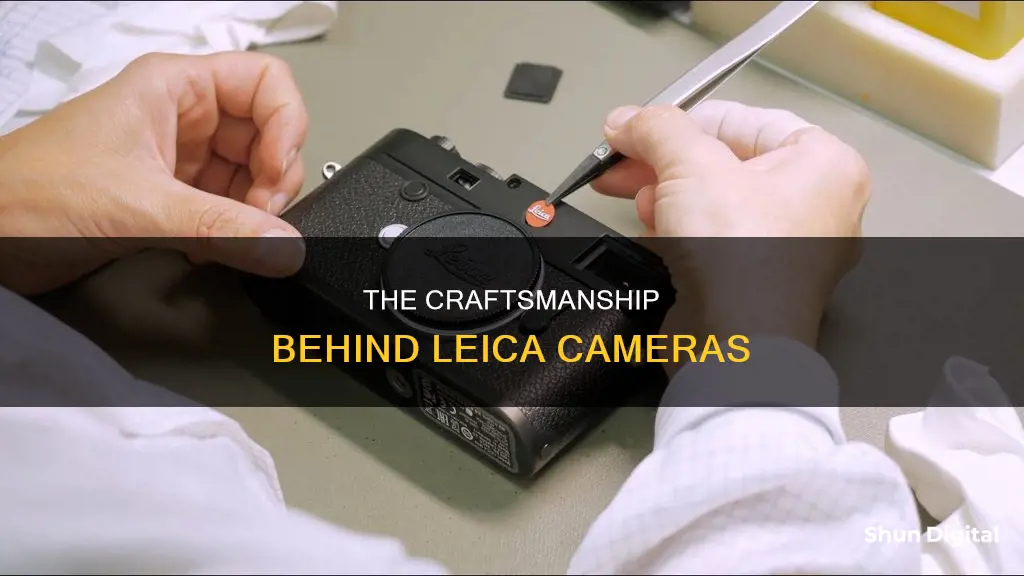
Leica Camera AG is a German company that manufactures cameras, optical lenses, photographic lenses, binoculars, and rifle scopes. The company was founded by Ernst Leitz in 1869 in Wetzlar, Germany. Leica cameras are hand-made in Germany, with eight assembly lines producing 500 cameras a day, mixing high-tech processes with a tradition of hand precision. The Leica M10, for example, is made from 1,100 individual components.
| Characteristics | Values |
|---|---|
| Company Name | Leica Camera AG |
| Company Founder | Ernst Leitz |
| Year of Foundation | 1869 |
| Original Location | Wetzlar, Germany |
| Current Location | Leitz Park 1, Wetzlar, Germany |
| Leica M10 Components | 1,100 individual components |
| Leica M10 Price | $6,895 |
| Leica Cameras Made In | Germany and Portugal |
What You'll Learn

Leica cameras are hand-made in Germany
Leica Camera AG is a German company that manufactures cameras, optical lenses, photographic lenses, binoculars, and rifle scopes. The company was founded by Ernst Leitz in 1869 in Wetzlar, Germany.
The Leica M has been around for more than sixty years, and the company's designers have always sought to reconcile new technical requirements with the distinctive appearance of this camera series. As such, the design process of a Leica M requires a unique approach, focusing on evolution rather than revolution.
Leica's headquarters can be found in Wetzlar, Germany, just 50 minutes from Frankfurt Airport. The main building is shaped like a film reel, and when viewed from above, it also resembles a camera lens. Leica's story began in this town more than 100 years ago when an employee of Leitz Werke created the first 'Lilliput camera', officially known as the ur-Leica.
Space Tesla Camera: Did the Battery Die?
You may want to see also

Leica's Wetzlar factory has eight assembly lines
Leica Camera AG is headquartered in Wetzlar, Germany, where it has eight assembly lines that produce 500 cameras a day. The Leica M10, for example, is made up of 1,100 individual components, including 30 milled from brass, 126 screws, and 17 optical elements. The Leica M10 is manufactured exclusively by highly qualified specialists at the Wetzlar factory.
The Leica M has been around for over 60 years, and the company's designers have always sought to reconcile new technical requirements with the distinctive appearance of the camera series. Leica's Wetzlar factory combines high-tech processes with a tradition of hand precision. The top and base plates of the Leica M10, for instance, are milled from solid blocks of metal and then ground and polished by hand in a 40-minute process.
Leica's manufacturing process involves more than 50 adjustment steps to achieve the utmost mechanical and optical precision. The assembly process spans from connecting the roller-lever with the rangefinder to calibrating the sensor and image board, and finally, attaching the back shell and top plate.
The Leica M10 is a masterpiece in the making, requiring exhaustive measures from Leica engineers to guarantee the exceptional quality expected from the brand.
Understanding Camera Raw Files: What, Why, and How?
You may want to see also

Leica M10 is made from 1,100 individual components
The Leica M10 is a masterpiece of engineering and craftsmanship, comprising 1,100 individual components that come together to create an exceptional camera. Each component is meticulously crafted and assembled by highly-qualified specialists, ensuring the camera's renowned quality, precision and perfection.
The Leica M10 is a full-frame digital rangefinder camera, the latest in a long line of esteemed M series cameras. Introduced in 2017, it builds upon the legacy of its predecessors while incorporating innovative features. One of its most notable aspects is its compact form factor, returning to the dimensions of its analogue predecessors while housing advanced digital capabilities.
The camera's 1,100 individual components include 30 parts milled from brass, 126 screws, and 17 optical elements. These components are meticulously assembled, requiring over 50 adjustment steps to achieve the utmost mechanical and optical precision. The inner workings of the camera are housed within a stable magnesium-alloy chassis, ensuring durability and protection for its intricate mechanisms.
The Leica M10's design and construction showcase a blend of tradition and innovation. The top and base plates, for example, are crafted from solid blocks of metal, ground and polished by hand in a meticulous 40-minute process. This blend of modern technology and traditional craftsmanship ensures that each camera is a testament to Leica's commitment to quality.
The camera's performance is just as impressive as its construction. It features a new 24 MP full-frame CMOS sensor, delivering exceptional imaging performance with impressive dynamic range, excellent contrast rendition, exceptional sharpness, and fine resolution of details. The ISO sensitivity range has been extended, offering values between 100 and 50,000, and significantly improving noise characteristics in exposures captured at higher ISO values.
Understanding Your Camera's Drive Mode Dial
You may want to see also

Leica's lenses are put together in Wetzlar
Leica Camera AG is headquartered in Wetzlar, Germany, where Leica lenses are put together. The company was founded in 1869 by Ernst Leitz in Wetzlar, and the name Leica is derived from the first three letters of the founder's surname and the first two of the word 'camera': lei-ca (LEItz CAmera).
The Leica M10, for example, is assembled from 1,100 individual components, including 30 that have been milled from brass, 126 screws, and 17 optical elements. The Leica M10 is exclusively manufactured by highly-qualified specialists at the factory in Wetzlar, Germany.
Leica's headquarters in Wetzlar is an impressive, purpose-built complex. The main building is shaped like a film reel, with a floor-to-ceiling glass facade that is custom-made to be convex and concave where necessary. When viewed from above, the building also looks like a camera lens.
Leica's factory in Wetzlar is a fascinating place, where the company's high-end cameras and lenses are crafted with precision and care.
Battery Pack Cameras: Powering Remote Photography
You may want to see also

Leica's factory has a special air filtering system
Leica's factory in Wetzlar, Germany, has a special air filtering system to keep the rooms dust-free. This is essential as Leica cameras are handmade, mixing high-tech processes with traditional hand precision. The Leica M10, for example, is assembled from 1,100 individual components.
The Leica factory in Wetzlar is a fascinating place to visit. The main building is shaped like a film reel, and when viewed from above, it looks like a camera lens. Leica has a long history in Wetzlar, dating back to the company's founder, Ernst Leitz, who established the company in 1869.
The Leica brand is renowned and has been used by many of the world's best photojournalists to document the defining events of the 20th century. Leica's high-quality miniature cameras have set a standard for mechanical precision that is arguably unmatched by any other manufacturer.
Leica's commitment to craftsmanship and precision is evident in every camera that leaves the facility.
Conditioning Camera Batteries: Prolonging Battery Life
You may want to see also
Frequently asked questions
Leica cameras are made from 1,100 individual components.
Leica cameras are handmade in Germany, mixing high-tech processes with a tradition of hand precision.
Leica has eight assembly lines that produce 500 cameras per day.
Leica lenses are put together in Wetzlar, Germany.
Some sources say that 90% of Leica cameras are made in Portugal, but others refute this claim.







